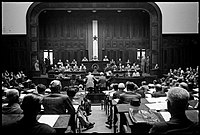Parliament of Yugoslavia
Parliament of Yugoslavia Народна скупштина | |
|---|---|
| Legislative body of Yugoslavia | |
 | |
| Type | |
| Type | Unicameral (1920–1931; 1942–1945) Bicameral (1931–1941; 1946–1963; 1974–2003) Pentacameral (1963–1967) Hexacameral (1967–1974) |
| History | |
| Founded | 1920 |
| Disbanded | 2003 |
| Succeeded by | Parliament of Serbia and Montenegro |
| Seats | 178 (at dissolution) |
| Elections | |
First election | 1920 |
Last election | 2000 |
| Meeting place | |
 | |
| Federal Assembly Building, Belgrade | |
| Constitution | |
| Constitution of Yugoslavia | |
Politics of Yugoslavia |
|---|
 |
| Administrative divisions |
|
The Parliament of Yugoslavia was the legislature of Yugoslavia. Before World War II in the Kingdom of Yugoslavia it was known as the National Assembly (Narodna skupština), while in the Socialist Federal Republic of Yugoslavia the name was changed to Federal Assembly (Serbo-Croatian: Savezna skupština/Савезна скупштина). It functioned from 1920 to 2003 and resided in the building which now convenes the National Assembly of Serbia.
Kingdom[]
The first parliamentary body of the state was the Temporary National Representation which existed until the first elections were held on 28 November 1920. The new parliament was known as the Constitutional Assembly. The assembly adopted the Vidovdan Constitution on 28 June 1921, after which it became known as the National Assembly.
After the end of the January 6th Dictatorship, in 1931 the kingdom returned to a constitutional monarchy and the National Assembly became the National Representation consisting of the National Assembly (lower chamber) and the Senate (upper chamber).
Anti-Fascist Council for the National Liberation of Yugoslavia[]
During the Axis occupation of Yugoslavia (1941−1944), the Anti-Fascist Council for the National Liberation of Yugoslavia (AVNOJ) was the political umbrella organization for the national liberation councils of the Yugoslav Resistance.
Socialist Federal Republic[]
As a result of the Treaty of Vis, AVNOJ was reformed into the Temporary National Assembly which also included several dozen members of the assembly elected in 1938. After the consolidation of power by the communists in late 1945, the Constitutional Assembly was established. The Constitutional Assembly was divided into two houses: the Federal Assembly, and the Assembly of Peoples.
With the adoption of a constitution in 1946, the name National Assembly was adopted again. It was divided into two councils (chambers):[1] the Federal Council, and the Council of Peoples.[2] In 1953, the Federal People's Assembly was divided into the Federal Council and the Council of Producers (from 1953 until 1967 the Council of Nations was a "sub-chamber" within the Federal Council).
In 1963 with the adoption of a new constitution, the Federal Assembly was divided into five councils: the Federal Council, the Economic Council, Educational-Cultural Council, Social-Health Council and the Organization-Political Council.[3] In 1967 the Council of Nations became it separate chamber, while in 1968 the Federal Council was demoted in favor of the Council of Nations and the Organization-Political Council changed its name into Socio-Political Council. The Federal Assembly of Yugoslavia was the only pentacameral (later hexacameral) legislature on the planet.[4]
The Federal Assembly was composed of appointed members from the League of Communists of Yugoslavia compiled from the Leagues of Communists of each constituent republic.
After the 1974 Yugoslav Constitution was adopted, the Assembly of the SFRY was bicameral, with the lower house called the Federal Chamber and upper house, the Chamber of Republics and Provinces. The Federal Chamber had 30 members from each Republic and 20 from each Autonomous Province, while the Chamber of Republics and Provinces had 12 members from each Republic and 8 from each Autonomous Province.[5]
When the League of Communists collapsed in 1990 amid ethnic tensions, the Assembly was shut down. The institution would be resurrected as the Federal Assembly of the Federal Republic of Yugoslavia in 1992, but this assembly had elected members.
Federal Republic[]
The Federal Republic of Yugoslavia legislature was bicameral and had 178 deputies, 138 in the House of Citizens (108 from Serbia, 30 from Montenegro) and 40 in the House of Republics (20 representatives for each republic). The minimum number of representatives in the House of Citizens, which were based on the population, was 30 representatives, while the House of Republics had an even representation of 20 representatives times the number of republics. A constitutional amendment in July 2000, as a compromise between the resignation of the Milošević cabinet and the opposition made the assembly's members elected, with the early elections set for September 24, 2000.
Gallery[]

The parliament in 1936

The parliament in 1945

The parliament in 1958
See also[]
- List of presidents of the Federal Assembly of the Socialist Federal Republic of Yugoslavia
- Parliament of Serbia and Montenegro
- National Assembly of Serbia - Serbia's parliament which is housed in the same building that had been the Federal Assembly building
- Parliamentary Assembly of Bosnia and Herzegovina
- Croatian Parliament
- Parliament of Montenegro
- Assembly of North Macedonia
- Slovenian Parliament
References[]
- ^ Throughout its existence, the Assembly was composed of "councils" (Serbo-Croatian: vijeće, pl. vijeća); actually these were "chambers" or "houses".
- ^ 1946 Constitution of Yugoslavia on WikiSource
- ^ 1963 Constitution of Yugoslavia on WikiSource
- ^ Lapenna, Ivo (1972). "Main features of the Yugoslav constitution 1946-1971". International and Comparative Law Quarterly. 21 (2): 209–229. doi:10.1093/iclqaj/21.2.209.
Ten years later, the Constitution of 1963 completely changed the whole structure of the Federal Assembly and of all the other organs of State authority. It introduced a heavy and complicated system of five or, in some cases, even six "Councils", for which the term "Chamber" seems more appropriate in order to avoid confusion between these bodies and various other councils.
- ^ 1974 Constitution of Yugoslavia on WikiSource
- Government of Yugoslavia
- Kingdom of Yugoslavia
- Socialist Federal Republic of Yugoslavia
- Politics of Yugoslavia
- Defunct bicameral legislatures
- 1920 establishments in Yugoslavia
- 1992 disestablishments in Yugoslavia
- Parliaments by country



